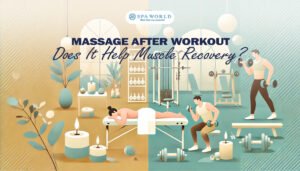At Spa World, one of the most common questions we encounter is, ‘How often should I get a massage?’ While a general guideline might suggest once a week or every two weeks, the ideal frequency really should be customized to your specific needs.
This includes considering various factors such as the type of massage, any health conditions you may have, your recovery needs from sports activities, and your current stress levels.
Now, let’s explore how each of these factors can influence the frequency of your massage sessions.
Determining the Ideal Frequency for Massages
1. Type of Massage
Swedish Massage
Frequency: Every one to two weeks.
Swedish Massage is otherwise known as Full Body Massage. This type focuses on relaxation and increasing circulation. As it’s generally gentle, it can be enjoyed more frequently, potentially every one to two weeks, as part of a regular self-care routine.
Deep Tissue Massage
Frequency: Every three to four weeks
Known for targeting deeper layers of muscles and connective tissue, it can be intense and might result in soreness post-session. Due to its intensity, reducing the frequency, possibly every three to four weeks is recommended to allow muscles adequate time to recover.
Shiatsu Massage
Frequency: Every two weeks to once a month; weekly for initial sessions if treating chronic pain.
Originating from Japan, Shiatsu is a therapeutic massage that involves applying pressure to specific points on the body which benefits in promoting relaxation, reducing stress, and improving overall well-being. If you’re undergoing high-stress periods, consider this massage every two weeks to once a month. If you’re dealing with chronic pain, it is recommended to get weekly sessions initially, gradually spacing them out as the condition improves.
Hot Stone Massage
Frequency: Every three to four weeks; bi-weekly for initial sessions if addressing muscle strain.
Hot stone massage involves using smooth, heated stones placed on specific points on the body to ease muscle tension and enhance relaxation. Due to its deeply relaxing nature, the frequency may vary. For stress relief, it is recommended every three to four weeks. If you’re experiencing any muscle strain, bi-weekly sessions are recommended initially.
Foot Reflexology
Frequency: Every one to two weeks.
Foot Reflexology is a practice where pressure is applied to specific points on the feet believed to correspond with different organs and systems in the body. Consider it for every one to two weeks to maintain general well-being.
2. Health Conditions
Chronic Pain or Conditions
Frequency: Weekly or bi-weekly.
More frequent massages may offer relief for those with chronic pain conditions like arthritis or ongoing back issues. Weekly or bi-weekly sessions might be beneficial in managing discomfort.
Injuries
Frequency: More frequent sessions initially, then spaced out as recovery progresses.
In the case of recent injuries, more frequent sessions might be necessary at the initial stages to aid in the healing process. As recovery progresses, sessions can be spaced out accordingly.
Pregnancy
Frequency: Monthly during the second trimester, increasing to every two weeks closer to the due date.
It is advised to avoid massages during the first trimester due to the increased risk of miscarriage during this period. If there are no complications, massages can be considered during the second and third trimesters.
For pregnant women, a monthly massage might be a good starting point during the second trimester. Based on individual preferences, the frequency can be increased to every two weeks as the due date approaches for additional relief and relaxation.
Note: At Spa World, we don’t provide any prenatal massage services at any stage of pregnancy.
3. Sports Performance Recovery
Training Intensity
Frequency: Weekly during peak training.
Athletes in high-intensity training might require more frequent massages to aid muscle recovery and prevent overuse injuries. During peak training, weekly sessions might be necessary.
Competition Schedule
Frequency: Increase frequency closer to competitions.
Closer to competitions, athletes might increase the frequency of massages to optimize performance and ensure their bodies are in peak condition.
4. Stress Relief and Wellness
High-Stress Lifestyle
Frequency: Weekly or bi-weekly.
Individuals with high stress levels might benefit from regular massages to manage stress levels. Weekly or bi-weekly sessions can assist in relaxation and stress reduction.
Maintenance of Well-being
Frequency: Monthly
For those seeking general relaxation and well-being, a monthly massage can serve as a treat and aid in maintaining balance and relaxation.
Conclusion
All these factors, like the type of massage, health condition, sports performance recovery, and stress relief, determine how often you should get a massage. To be precise, it’s tailored to individual needs and preferences, keeping these factors in mind.
If you’re around Houston, you are lucky as you have Spa World to experience the ultimate relaxation and rejuvenation.







